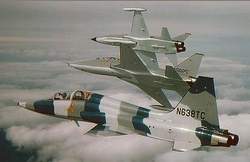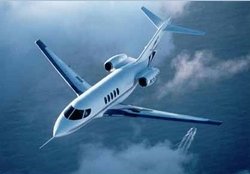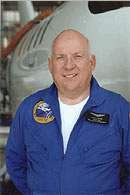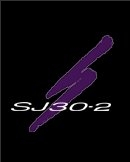 The NTSB has relleased the preliminary report on
the recent fatal accident that claimed the life of Test Pilot
Carroll Beeler. Herewith, the preliminary report:
The NTSB has relleased the preliminary report on
the recent fatal accident that claimed the life of Test Pilot
Carroll Beeler. Herewith, the preliminary report:
HISTORY OF FLIGHT
On April 26, 2003, at 1005 central daylight time, a
Sino-Swearingen Aircraft Corporation (SSAC) SJ30-2, N138BF, serial
number 002, was destroyed when it impacted terrain near Loma Alta,
Texas. The certificated airline transport pilot was fatally
injured. Visual meteorological conditions prevailed for the flight,
which departed on an instrument flight rules flight plan from San
Antonio International Airport (SAT), San Antonio, Texas, at 0911.
The local test flight was conducted under 14 CFR Part 91.
According to company flight test personnel, the mission, flight
test number 231, was the second in a series of flights to complete
SSAC Report 30-2222, "Flight Flutter Certification Test Plan for
SSAC SJ30-2" requirements.
The first flutter mission, flight test number 230, was flown one
day earlier with the same pilot onboard. The pilot terminated the
flight after an uncommanded roll to the left, and a subsequent
discrepancy was noticed between his displayed airspeeds and those
reported by a chase plane pilot.
After the flight, the pilot realized that he had incorrectly set
up the airspeed display in the test airplane. When he thought he
had completed a test point at indicated Mach 0.860, he had actually
completed it at indicated Mach 0.878.

The pilot also reported to flight test personnel that during the
flight, he had felt a "rumble" in conjunction with the left roll
at, according to his notes, indicated Mach 0.855. Immediately
beneath the left roll comment, he had written, "Rudder input?"
According to the project's flutter consultant Designated
Engineering Representative (DER), a possible explanation for the
rumble was Mach buffet. However, to confirm that there wasn't a
mechanical problem with the airplane, flight test personnel
assigned a second SSAC pilot as a backseat chase plane observer for
the next (accident) flight.
 The chase airplane was a contracted Northrop T-38,
N638TC (seen right), with a pilot and the second SSAC test pilot
onboard during the accident flight. The accident flight was also
being monitored in a telemetry van in Rock Springs, Texas, by the
flutter consultant and three SSAC personnel.
The chase airplane was a contracted Northrop T-38,
N638TC (seen right), with a pilot and the second SSAC test pilot
onboard during the accident flight. The accident flight was also
being monitored in a telemetry van in Rock Springs, Texas, by the
flutter consultant and three SSAC personnel.
Prior to the test flight, a mission briefing, led by the
accident test pilot, was conducted via conference call between the
San Antonio-based personnel and the telemetry van personnel.
According to a briefing participant, all of the flight test cards
were covered, "including the test limitations, test set-up, test
points, weight and balance, airspace operational considerations,
aircraft limitations, maintenance actions since last flight,
instrumentation status, and chase aircraft procedures."
An "SSAC Flight Briefing Guide" was also utilized, which
included a review of hazard analyses, and abnormal/emergency
procedures. During the briefing, the test pilot stated that he was
responsible for safety of flight.
The flutter consultant also noted that he had, during previous
discussions, advised that for the purpose of flutter testing, if
the pilot ran out of aileron/elevator trim, the tests could still
be completed, even if the pilot had to hold aileron/elevator force
to steady the airplane. He further stated, however, that the
continuance of the testing would never override the pilot's
decision as to whether the control forces were unacceptable or
hazardous.

According to the flutter consultant, after takeoff, the airplane
climbed to 39,000 feet and set up for a shallow dive along a
090-degree track for flight test point 1-14 (indicated Mach
0.884).
A telemetry lock was then obtained. However, when the airplane
reached indicated Mach 0.875, the test pilot called "Mark" on the
radio to duplicate the previous day's test point.
After the "Mark" was received, the pilot initiated a single
pulse input to the elevator. After checking the telemetry strips,
the consultant then gave a "Go" for a single pulse to the aileron,
followed by another "Go" for a single pulse to the rudder.
Telemetry van personnel noted that all the modes excited were "well
damped."
Telemetry van personnel also reported that after the pulses were
completed, the test pilot stated that the uncommanded roll to the
left (which was experienced on the previous flight), did not occur.
There was also no mention of a rumble. In addition, the chase plane
pilots confirmed that there were no mechanical anomalies evident on
the accident airplane.
According to the flutter consultant, the accident airplane
subsequently turned back to the west and began to climb back to
39,000 feet to set up for the dive to the 1-14 point along a
270-degree magnetic track. Discussion between the pilot and
telemetry van personnel indicated that the 1-14 point might be the
last one of the mission due to fuel concerns, especially for the
chase airplane.
Following telemetry lock, the airplane began a shallow dive.
According to most of the participating personnel, prior to reaching
the test point of indicated Mach 0.884, the pilot reported that he
had put in full trim and couldn't let go. At indicated Mach 0.884,
the pilot called "Mark." Each control surface was again pulsed by
the pilot, and the responses were again "well damped."
Following the final pulse, the pilot was cleared to the next
test point, 1-15 (indicated Mach 0.894), "if flight conditions
permitted the test pilot to do so." However, the pilot did not
acknowledge the clearance, but instead, reported that the airplane
was rolling to the right, and he couldn't stop it. Telemetry was
lost about 20 seconds later.

The chase airplane pilot confirmed that after the 1-14 test
point had been completed, the test pilot was cleared to accelerate
to the 1-15 test point, if able. At that time, the test airplane
appeared to be in a shallow right bank with the chase airplane less
than 500 feet above and 500 feet behind it.
"Very soon thereafter," about 30,000 feet, the test airplane
began rolling to the right. The rolling maneuver appeared to be
stable, and continued unchanged until ground impact. The test
airplane appeared to remain intact throughout the event, and no
parts were seen departing the airframe. After the test airplane
began to roll, and the test pilot stated that he couldn't stop it,
the chase pilot called, "get out" twice. The test pilot responded
that he couldn't get out, that there were too many "g's."
The second SSAC test pilot, in the back of the chase airplane,
also noted that the accident sequence began after the completion of
the 1-14 test point. During the sequence, the chase airplane was
not close enough to observe the test airplane's control
positions.
The second test pilot observed the test airplane's nose to be "a
little low," and in an approximately 30-degree right bank after
test point 1-14 was completed. After a few seconds, the test
airplane entered a "barrel-roll type maneuver" to the right, then
continued to roll, and increased its dive angle until ground
impact.
When the second test pilot saw the first roll, his first thought
was, "what did he do that for?" Then he saw that the airplane "came
around and made another barrel roll. It was not around a point like
an aileron roll; and it was not real fast; it looked lazy." The
chase pilot then mentioned the roll to the accident pilot, who
replied that he couldn't stop it. The accident pilot did not say
anything further about how the airplane was performing, or what he
was experiencing.
PERSONNEL INFORMATION
 The pilot (Carroll Beeler, seen right) held an
airline transport pilot certificate, with ratings for the Boeing
707, 727, and 747, and Airbus 300. He was also a retired Navy pilot
with combat experience in the Vought F8J Crusader, and had
subsequent flight test experience with several major aerospace
manufacturers. His latest Federal Aviation Administration second
class medical certificate was issued on July 3, 2002. At the time,
the pilot reported 12,000 hours of total flight time.
The pilot (Carroll Beeler, seen right) held an
airline transport pilot certificate, with ratings for the Boeing
707, 727, and 747, and Airbus 300. He was also a retired Navy pilot
with combat experience in the Vought F8J Crusader, and had
subsequent flight test experience with several major aerospace
manufacturers. His latest Federal Aviation Administration second
class medical certificate was issued on July 3, 2002. At the time,
the pilot reported 12,000 hours of total flight time.
According to SSAC records, the pilot joined the company in 1997.
Prior to the accident flight, the pilot had accumulated 271 flight
hours in the accident airplane, and 331 flight hours in SSAC
airplane number 001.
According to a technical services agreement, the flutter
consultant DER was hired to "provide oversight and guidance in the
execution and documentation of flutter analysis" for certification
compliance with FAR 23. In conjunction with the agreement, the
consultant was "given authority as director of test preparation,
test conduct, and analysis of results."
AIRCRAFT INFORMATION
The accident airplane, serial number 002, was a
non-type-certificated experimental research and development
aircraft. On September 24, 2002, the Federal Aviation
Administration (FAA) issued the airplane a Special Airworthiness
Certificate with Experimental Operating Limitations for the Purpose
of Research and Development.
The airplane was inspected using an Approved Aircraft Inspection
Program (AAIP) titled "SJ30-2 Inspection Procedures Aircraft S/N
002, Report Number: QA-INSP-500 (QA-500)." Data accumulated during
the airplane's design and operational testing was analyzed to
formulate the inspection program requirements.
Inspections included the First Flight of Day Inspection, Next
Flight Inspection, After Last Flight Inspection, Periodic/Phase
Inspections (A, B, C) and Special Inspections. The Periodic/Phase
inspections were accomplished at 100-hour intervals. Inspections
were recorded on the Flight Test Work Order (FTWO).
Aircraft maintenance manuals had not been developed for the
airplane. Maintenance was accomplished by FAA-certificated
technicians using aircraft drawings and specifications in
conjunction with vendor component maintenance manuals. Maintenance
work was also recorded on the FTWO.
The last Periodic/Phase Inspection was a "B" Check, accomplished
on January 14, 2003, at 284.2 hours. A First Flight of Day
Inspection was accomplished on April 26, 2003, for the accident
flight, at 315.9 hours.

METEROLOGICAL INFORMATION
Weather, recorded at an airport about 35 nautical miles to the
south, included clear skies, winds from 330 degrees true at 10
knots, and 10 miles visibility.
WRECKAGE AND IMPACT INFORMATION
The wreckage was located at 29 degrees, 52.37 minutes north
latitude, 100 degrees, 57.65 minutes west longitude, about 250
degrees magnetic, 10 nautical miles southwest of Loma Alta, Texas,
and 350 degrees magnetic, 30 nautical miles north of Del Rio,
Texas.
The accident site was located in a remote area of sparsely
vegetated plateaus and canyons, at an elevation of 1,741 feet, near
the top of one of the plateaus. The main crater was cut almost
straight down, about 5 feet, into a sandstone formation. There were
additional cuts, consistent with wing positions, oriented along a
085/265-degrees magnetic axis.
The wreckage was fragmented, with debris spread over an area of
approximately 9 acres, dispersed 360 degrees around the impact
crater. Evidence of all flight control surfaces was found at the
scene. Slat tracks were identified; however, no slat structures
were identified in the debris field. There was no evidence of
in-flight fire or in-flight failure of structural elements, and all
fracture surfaces examined exhibited evidence of static overload.
Control continuity could not be confirmed due to the severity of
the impact damage.
ADDITIONAL INFORMATION
 The airplane was equipped with a trailing cone for
static air pressure and a nose boom for dynamic air pressure. The
combined inputs resulted in a "reference system airspeed." The
pilot would have had to operate two cockpit switches to be able to
display reference system airspeed. Failure to do so would have
resulted in him reading a lower airspeed, generated from the
airplane's internal airspeed indicating system.
The airplane was equipped with a trailing cone for
static air pressure and a nose boom for dynamic air pressure. The
combined inputs resulted in a "reference system airspeed." The
pilot would have had to operate two cockpit switches to be able to
display reference system airspeed. Failure to do so would have
resulted in him reading a lower airspeed, generated from the
airplane's internal airspeed indicating system.
The telemetry van was receiving reference system airspeed. One
of the telemetry personnel stated that as the accident sequence
approached, the airplane's airspeed readout was consistently
between Mach 0.881 and 0.882. He subsequently noted that he did not
believe the airplane exceeded Mach 0.882 before the telemetry
signal was lost.
Hard drives containing over 450 flight parameters were onboard
the airplane. The hard drives were recovered; however, their
condition precluded any data recovery.
The telemetry data included 27 parameters, most of which were
accelerations. Additional parameters included Mach, altitude,
calibrated airspeed, magnetic heading, ventral rudder position,
rudder position, and elevator position. The telemetry data was
forwarded to the Safety Board for review.
 ANN's Daily Aero-Linx (04.13.24)
ANN's Daily Aero-Linx (04.13.24) ANN's Daily Aero-Term (04.13.24): Beyond Visual Line Of Sight (BVLOS)
ANN's Daily Aero-Term (04.13.24): Beyond Visual Line Of Sight (BVLOS) Airborne 04.09.24: SnF24!, Piper-DeltaHawk!, Fisher Update, Junkers
Airborne 04.09.24: SnF24!, Piper-DeltaHawk!, Fisher Update, Junkers Aero-News: Quote of the Day (04.14.24)
Aero-News: Quote of the Day (04.14.24) ANN's Daily Aero-Term (04.14.24): Maximum Authorized Altitude
ANN's Daily Aero-Term (04.14.24): Maximum Authorized Altitude










